Moving Rare Book Instruction Online: Filming a 15th Century Medieval Choir Book
Posted by Jane Metters LaBarbara.November 30th, 2020
Blog post by Stewart Plein, Associate Curator for WV Books & Printed Resources & Rare Book Librarian
I think we can all agree that the pandemic has brought a number of changes to our daily routines. We’ve had to rethink everything in our lives, from the most basic and necessary, like simply going to the grocery store, to how we handle work related tasks, like instruction. In order to protect our students and faculty, WVU moved much of its fall semester instruction online. That included instruction for rare books too.
Back in the spring, when life during the pandemic began to be referred to as the “new normal,” it seemed clear that the fall semester wouldn’t be returning to the pre-Covid normal we had all hoped for. Taking this into consideration, the big question uppermost on my mind was how to handle rare book instruction? It was going to take some planning!
At that time, I wasn’t even sure that professors would want to add rare book instruction to their courses so I was delighted when I received several requests from faculty to develop sessions for their students virtually. The only problem? I’d never taught online before! A lot of time was put into researching best practices and approaches, attempting to learn how to use Zoom, something that was totally new to me, the mechanics of delivering rare book instruction virtually, and basically, how I would manage to accomplish this and provide meaningful instruction that students would find interesting and educational.
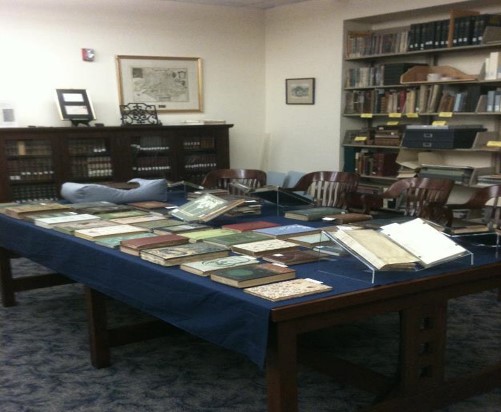
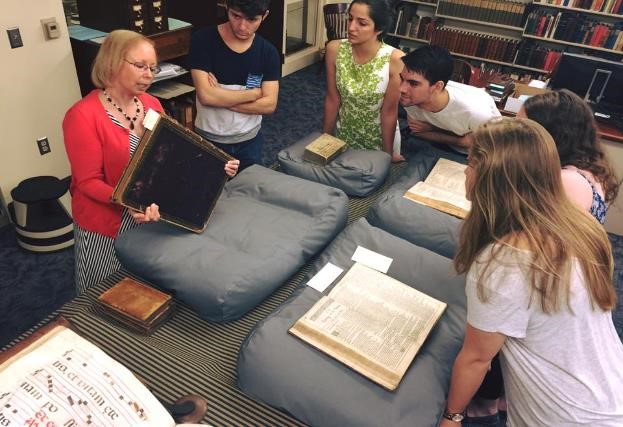
Before the pandemic, scheduling and developing classroom content was determined in a few, easy steps. Following a faculty member’s request, we’d meet, via email or in person, to discuss content, consider texts, and look over the syllabus. Often, I met faculty in the rare book room, especially those who were using rare books in their class for the first time. During our meeting we would view the space to see if it was suitable for their needs, select books that would be appropriate, and make final decisions about content. Then we’d be all set to go! While some of the same procedures could be followed for virtual instruction via email or in a Zoom meeting, simply pulling the books off the shelf and creating a display for students to examine, as well as holding in person classes, like the one shown above, was no longer an option.
The bottom line – to make rare books available virtually it was going to take a village and a lot of time! Moving instruction online would require scanning fragile primary resources in order for students to be able to see them virtually. I had received several requests for students to view a 15th century monastic choir book, for both synchronous and asynchronous instruction. Synchronous instruction is defined as a live class, in person or virtual, with both students and faculty/instructors in attendance at the same time. Asynchronous instruction can be defined as instructional materials prepared in advance for students to view at their convenience. The task before us was to make the choir book suitable to both forms of instruction, so that’s what I decided to tackle first.
Here’s how we did it:
First, I reached out to colleagues in the West Virginia and Regional History Center, Jessica Eichlin, our reference supervisor who has a real talent when it comes to scanning and using a camera, and Lemley Mullett, our photographs manager, who has experience creating some of the videos you see used in our exhibitions. The three of us met to talk about our approach, and then we devised a plan.
The book in question is a missal, or gradual; which is a collection of music for the service of mass covering the Catholic church year. Although the volume is not dated, there are plenty of clues, such as the binding itself and the sewing structure that holds it together, two elements that vary over time that led us to approximate the date to around 1450. The gradual is very large. It takes two people, myself and someone else, to move it. It is a medieval manuscript, made before Gutenberg invented the printing press, and therefore, it was entirely handmade at the Dominican monastery in Seville, Spain where it was used.
Unlike books you see today, the manuscript was made without the aid of all the modern technological advances in machinery and manufacturing that are used to produce books today. For this book, the boards were cut from an oak tree. Plants were grown, harvested, dried, and then their fibers were braided and used to bind the book. The pages, called leaves at this time, are made from vellum., also known as parchment, which is made from calf skin. The text, hand written by scribes, is Latin, not Spanish, as one might assume since it was made at a Spanish monastery. The musical notes are square, which is indicative of chant. As can be imagined, we wanted to take great care with this book.
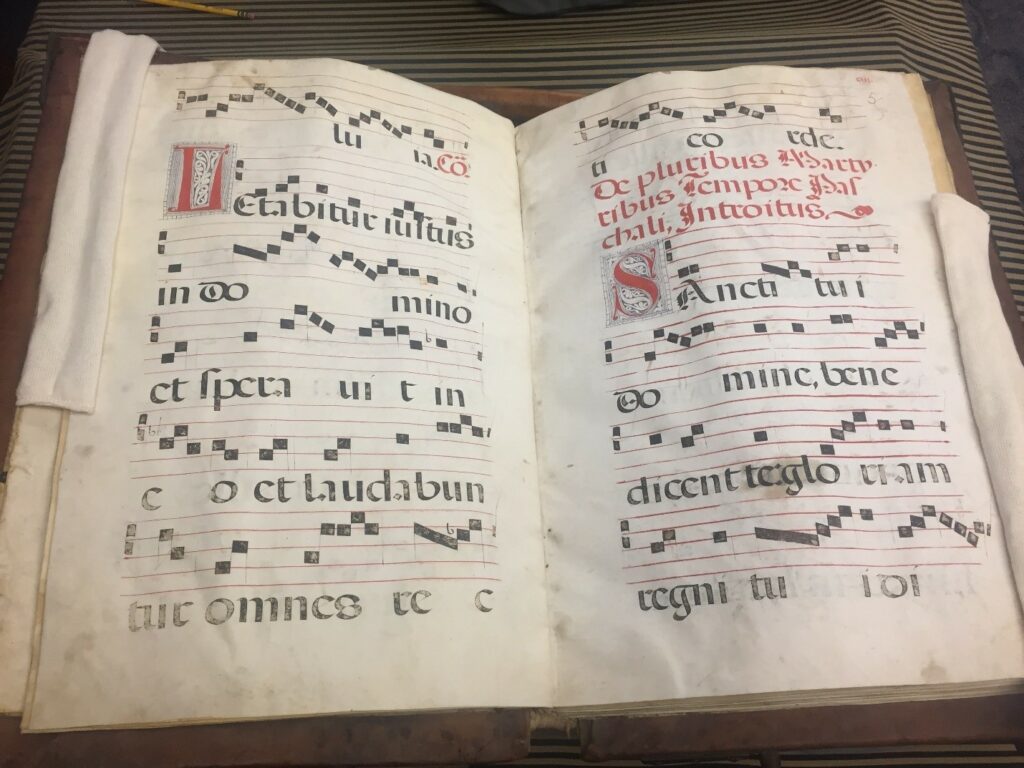
A two-page spread of the vellum pages showing the Latin text and musical notations for Chant, a droning, monotone type of choral singing.
We decided filming the book would be the best approach. We would position the book on appropriate supports and film each page as it was being turned.

The choir book is positioned carefully on a pillow designed to support rare books. It sits on the table in the rare book room. You can see the tripod for the camera positioned on top of the table above it. Our camera pro, Jessica Eichlin, is on the right.
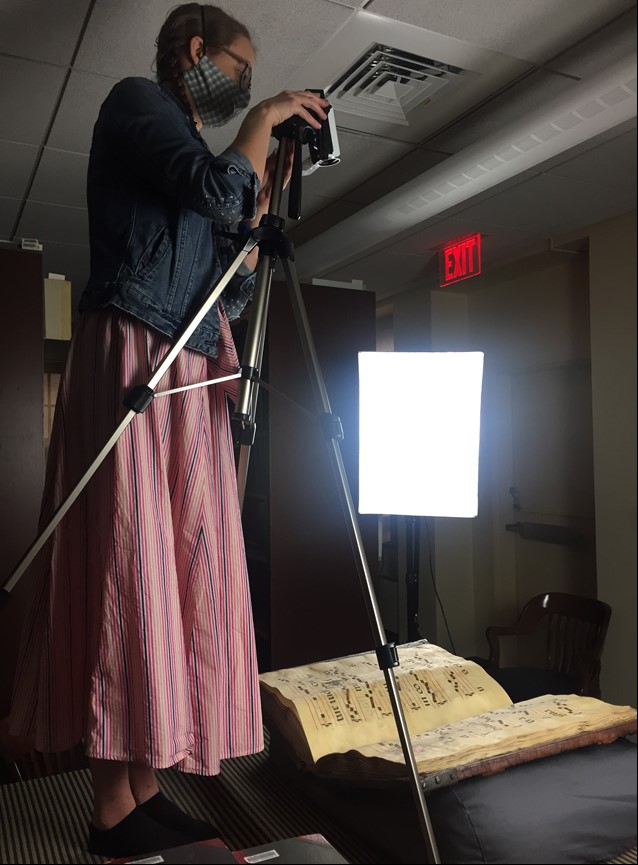
As you can see, arranging the camera to film the gradual took a bit of maneuvering! Jessica is standing on top of the table in her socks, positioning the camera to film the book.
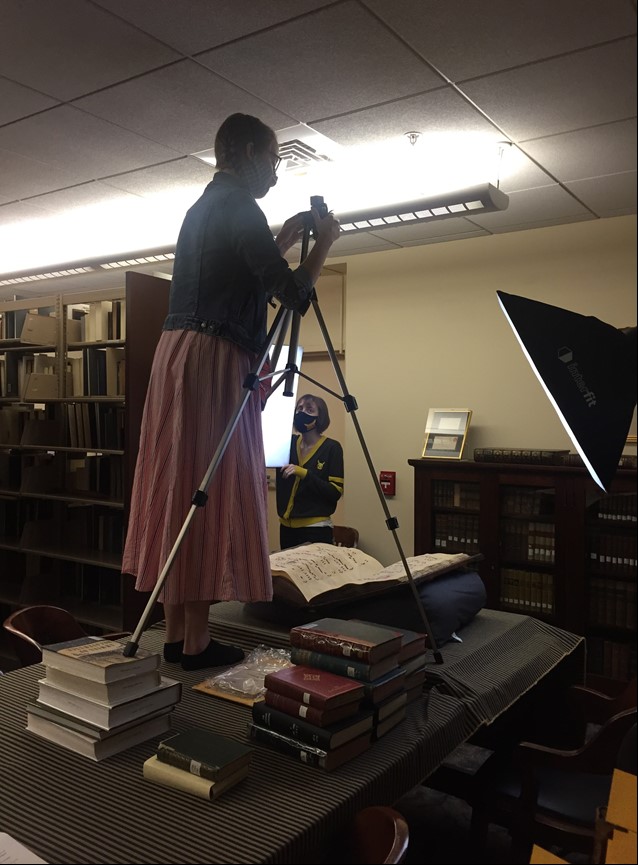
Lemley Mullett positions the light boxes to get the best angle, Jessica handles the camera. One leg of the tripod required a higher position to get the camera at the appropriate height. I can assure you that no rare books were used or harmed in this process!
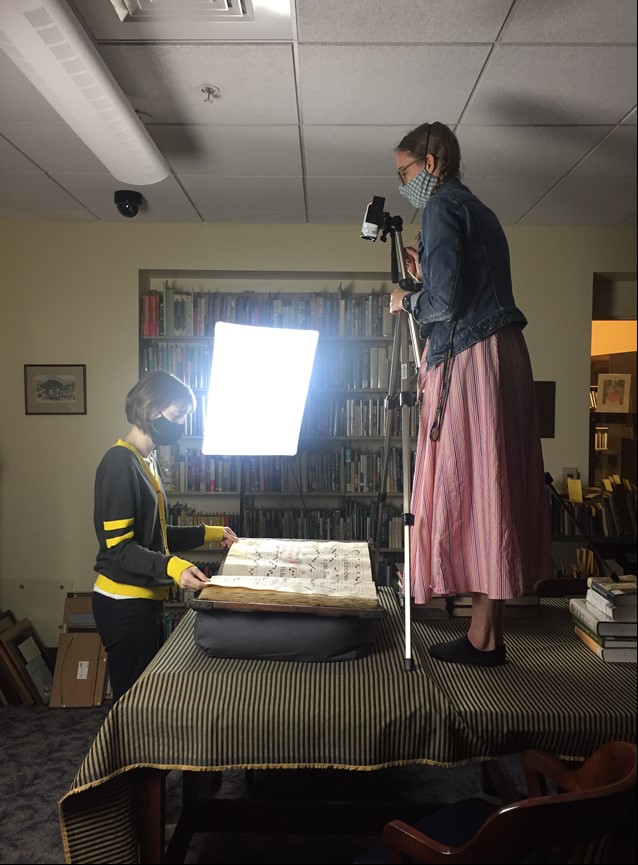
Lemley gets in position. In the first phase of the film, Lemley will turn each page of the book. Note, she is not wearing gloves. Freshly washed, clean hands are the best approach when turning fragile pages. Gloves only get in the way and make turning pages more difficult.
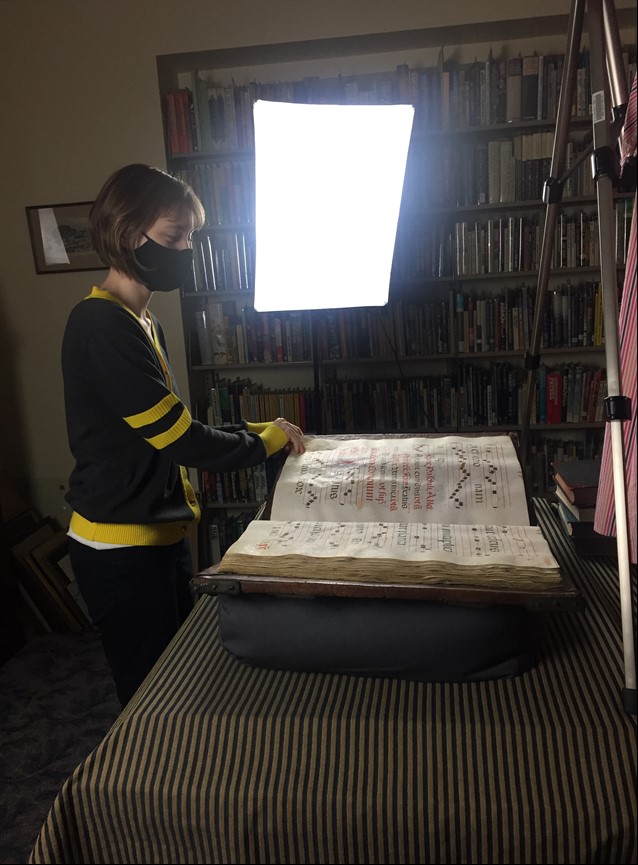
The filming begins! Lemley starts turning the pages while Jessica handles the filming process.
Phase one is now complete! Click here to view the first phase of the video with Lemley turning the medieval pages. There is no audio at this point. The video is called Turning Leaves: A Look at a 15th Century Choir Book: https://youtu.be/U-u8WCg__aM
In a live class, I can embed this link in a PowerPoint, or click on the link itself, and share my screen virtually in a Zoom class session so that all the students can see it as I’m showing it to them. While the video is in play, I can then push the pause button and take a few moments to discuss specific details. Then I can push play and we’re on to the next page.
Now it’s time for phase two! The final classroom instruction that will be layered over the video has two parts. First, my task is to use this video as the basis for my instruction. The plan is to record this version as a Zoom session that will be available for asynchronous course instruction. I will pause at points during the video to discuss details as they arise. Second, I’ll use a PowerPoint presentation to zoom in on specific details and discuss them for student viewing.
There were a few stops and starts along the way. If I misspoke, or accidentally hit the wrong button, and I assure you I did, I had to start over. Narrating the video with educational instruction took a few times for me to get it right in order to develop a level of comfort during recording as well as making certain I had covered all the points I wanted to say. In the end, after a few false starts, I was pleased with the result, even though I turned a slide or two too soon towards the end!
You may view the final video with my instruction here: https://youtu.be/Y9-c6ceNgjw. This video is called Gradual: A Look at a 15th Century Choir Book.
In closing, during a time when accessibility is limited due to the pandemic, it’s important to continue our mission to make our primary resources available to our students. Now you have the opportunity to see behind the scenes as we create instruction in a way that makes our collections available in these challenging times. If you share these videos with your group, please let me know! I’d love to hear how you used them!
Got questions? I’m available!





